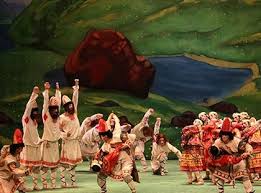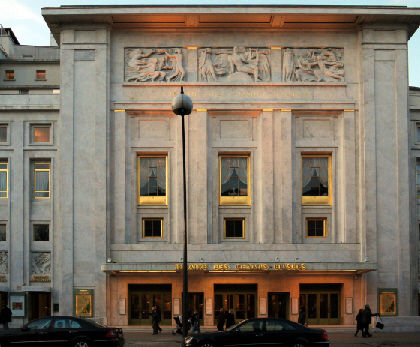The Rite of Spring at 100

Richmond, Virginia Production
Yesterday, 29 May 2013 was the 100th anniversary of the premiere of The Rite of Spring (Le Sacre du Printemps), a revolutionary ballet choreographed by Vaslav Nijinsky, set to Igor Stravinsky's score, produced by Serge Diaghilev for his Ballet Russes, and staged at the Theatre des Champs-Élysées in Paris. The ballet is set in pagan Russian times; the rite of spring is the ritual sacrifice of a maiden (The Chosen One) to ensure successful crops. The music, choreography, costumes, and staging were unlike anything ever seen before: discordant, irregular, and wild, poles apart from the classic Les Sylphides, which opened the evening's performance. It was rather well received by bohemians in the audience but loudly rejected by the bourgeoisie. Fights broke out in the audience, objects were hurled at the orchestra, the dancers could barely hear the music, at least 40 attendees were taken away by the police...but the performance continued through to the end and by then the remaining audience members had somewhat settled down.
Modris Ecksteins opens his excellent book The Rite of Spring: The Great War and the Birth of the Modern Age, with a detailed description of the premiere and an analysis of its importance. He sees The Rite as "perhaps the emblematic oeuvre of a twentieth-century world that, in its pursuit of life, has killed off millions of its best human beings."
The premiere soon came to be seen as a cultural fracture point—evidenced by the breaking of the fourth wall, the lack of familiar music and dance structure, the public release of wild, even violent emotion, the display of ritual violence on stage, and the breakdown of established norms of behavior. Symbolically, it came to represent or foreshadow the unrestrained horrors of the Great War and the sweeping social and cultural changes that followed it. Times changed and audiences adapted. By 1930, when the ballet premiered in the U.S., with Martha Graham as The Chosen One, New York audiences reacted positively. By 1940 Walt Disney was using the score in Fantasia.
Music and ballet historians estimate that more than 150 different productions of The Rite of Spring have been created, bringing numerous variations to the original story line and choreography, including male victims, child victims, the introduction of a lover who takes revenge on the elders, and a feminist one that stresses the misogyny directed toward the victim.

2013 has brought numerous re-stagings of the ballet and concert versions by companies across the world. Notably, the ballet was performed on the anniversay at the site of its Paris premiere by Valery Gergiev and the St. Petersburg-based Mariinsky Orchestra and Ballet, using the restored Nijinsky original choreography.
Order Now |
The premiere soon came to be seen as a cultural fracture point—evidenced by the breaking of the fourth wall, the lack of familiar music and dance structure, the public release of wild, even violent emotion, the display of ritual violence on stage, and the breakdown of established norms of behavior. Symbolically, it came to represent or foreshadow the unrestrained horrors of the Great War and the sweeping social and cultural changes that followed it. Times changed and audiences adapted. By 1930, when the ballet premiered in the U.S., with Martha Graham as The Chosen One, New York audiences reacted positively. By 1940 Walt Disney was using the score in Fantasia.
Music and ballet historians estimate that more than 150 different productions of The Rite of Spring have been created, bringing numerous variations to the original story line and choreography, including male victims, child victims, the introduction of a lover who takes revenge on the elders, and a feminist one that stresses the misogyny directed toward the victim.


No comments:
Post a Comment